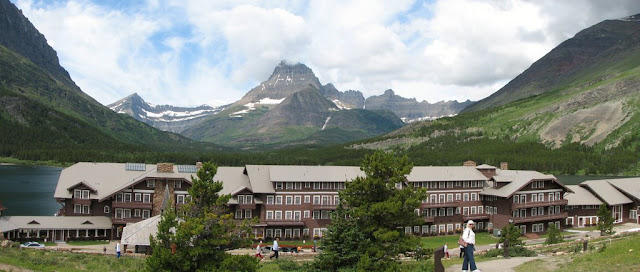I have reduced the file size of these on-line pictures to conserve storage space. I have the full sized file available.
We left Reed Point and headed to Shelby MT. Most of the trip was done on state routes rather than the interstate. Our route took us through Great Falls MT. We took a road that ran along the Missouri River and saw the falls that Lewis & Clark discovered during their expedition. As we follow the river Jackie was saying what a beautiful ride it was and it would be nice just to sit and watch the river. Well, as luck would have it, we came upon a place where I could park the motor home. Since it was close to lunch we stopped.
Earlier that day we went past a large wind farm. I was going to try to count the number of wind generators but there were too many of them . So I just kept saying . “Wow, look at all those wind generators”. In our travels I have seen a lot of the wind generators in Europe and wondered why I didn’t see any in the U.S. It’s clear now, I wasn’t in the right place to see them. One thing is certain about wind generators, they take up a lot of space. I saw a show that was a little discouraging in that the message was that if you consider how much land you need to produce enough “green” power to replace oil, we don’t have enough available land. The metric used was “Kilowatts per acre”. While wind and solar energy do produce energy, the kilowatts per acre is a small number relative to a coal or oil fired power plant. There is much work needed in improving the energy output of wind and solar devices.
Driving and thinking about kilowatts per acre can make a guy hungry. After setting up at our campground, it was time to eat. Nothing like a home cooked meal. And, by the way there was another wind farm within sight of our campground. That night I was out looking at the stars and noticed that all the wind generators had red warning lights on and that they were all flashing in unison. The light must be there to warn small aircraft.
Shelby is on the east side of Glacier National Park (GNP) and is about 50 mile away. On the way there you go through the towns of Cut Bank and Browning. One of the historic points we stopped at was Camp Disappointment. It marks the furthers point north of the Lewis & Clark expedition. Lewis had hoped that the Marias headwaters rose north of the 49th parallel. As that would have extended the boundaries of the Louisiana Purchase.
Montana grows a lot of wheat. In Nebraska, Kansas, etc we saw coal trains that were a mile or so long. They would normally have two engines in front pulling and two engines in back pushing. Here in Montana the trains we have seen are either transporting grain or containers. There are grains elevators along the tracks that fill the cars.
The Blackfeet Reservation is a large area east of GNP. This is their ancestral lands. If you are wondering how they got their name, here is a tidbit. “"Blackfoot" is the English translation of the word siksika, which means "black foot." It refers to the dark colored moccasins the people wore, which may have been darkened by dye or by walking through burnt grass after common prairie fires.” Jackie took some pictures as we past through the town of Browning.
We have spent three days in GMP. So our pictures are a compilation and reflect the weather that we experienced here. What a place. The scenery is fantastic, from water falls to mountain peaks. We spent a day on a Red bus tour that went over the Going to the Sun Road from the west to east. We had a lunch stop at the Many Glacier Lodge. This lodge was built by the Great Northern Railroad to entice people to ride their trains and come to the park. During this trip and when we drove back to Logan’s pass in our car, we were lucky to see many animals. Jackie was talking to a resident and he told her that the reason we saw bears was the cold, foggy / misty day. That kind of weather encourages the bears to come out and forage. On sunny days they hole up and wait for evening.
This last picture is of a marmot escaping under a construction barrier. He was scooting around on a narrow part of the road. As I approached he ran in a couple of circles and then made his escape.
If you want a peak of what RVing pitfalls can be like, see: Give it more gas,
http://www.youtube.com/watch?v=uiBfmGYv6bY



















































